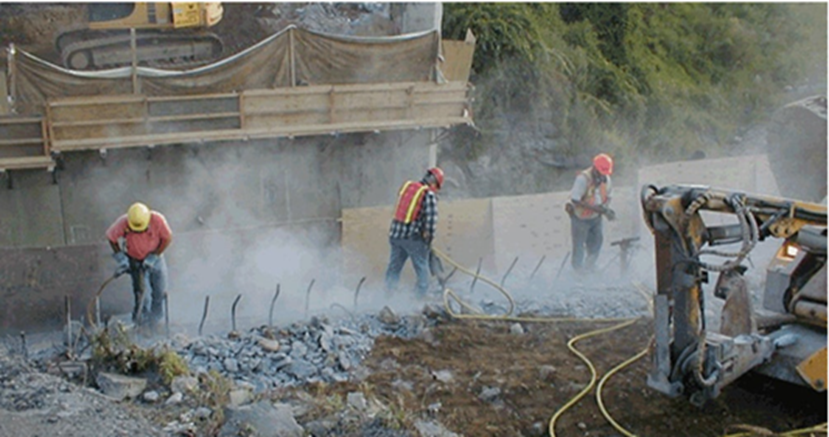Did you know the absence of effective dust controls and poor work practices on construction sites can result in silica exposures above occupational exposure limits?
Crystalline silica is a chemical compound of atoms of the elements silicon and oxygen arranged in a repeating three-dimensional pattern. Quartz is the most common form of crystalline silica; tridymite and cristobalite are two similar forms. Dust is the name for solid particles made when a hard substance like rock is crushed, ground up, or broken. Respirable dust consists of particles small enough to reach the air sacs (alveoli) deep in the lungs. This means that respirable crystalline silica is silica dust capable of reaching the alveolar region of the lungs, produced by crushing, grinding, cutting, drilling, and breaking material that contains crystalline silica. Crystalline silica is found in sand, gravel, Portland cement concrete, asphalt pavement, ceramics, brick, block, mortar, and other materials.
Respirable crystalline silica is the sole cause of silicosis, a fibrotic disease of the lungs. Silicosis takes three forms: chronic, acute, and accelerated. Chronic silicosis has a long latency (from 20-45 years) and is limited to isolated nodules. Occasionally, progressive massive fibrosis (PMF) develops as a complication, destroying underlying tissue and blood vessels. Accelerated silicosis, associated with higher exposures, progresses faster and PMF is more frequent. Acute silicosis is a rapidly fatal disease associated with extremely high, short duration exposures to silica dust, resulting in marked interstitial fibrosis, pneumonitis, and alveolar proteinosis. Silicosis is irreversible, often progressive (even after exposure has ceased), and potentially fatal. Because no effective treatment exists for silicosis, prevention through exposure control is essential. Silicosis is associated with a higher risk of tuberculosis and other lung disease. Exposure to respirable crystalline silica is also associated with autoimmune disorders, kidney disease, and lung cancer.
The OSHA Permissible Exposure Limit (PEL) for respirable dust containing crystalline silica for the construction industry is 0.05 mg/m3, as an 8-hour Time Weighted Average (TWA). The NIOSH Recommended Exposure Limit (REL) for respirable crystalline silica is 0.05 mg/m3 as a TWA determined during a full-shift sample for up to a 10-hr workday during a 40-hr workweek to reduce the risk of developing silicosis, lung cancer, and other adverse health effects. When source controls cannot keep exposures below the REL, NIOSH also recommends minimizing the risk of illness that remains for workers exposed at the REL by substituting less hazardous materials for crystalline silica when feasible, by using appropriate respiratory protection, and by making medical examinations available to exposed workers.
The American Conference of Governmental Industrial Hygienists (ACGIH®) Threshold Limit Value (TLV®) for α-quartz and cristobalite (respirable fraction) is 0.025 mg/m3 as an 8-hr TWA. The limit is based on the role of silica exposure in the development of pulmonary fibrosis and lung cancer. ACGIH® recommends that exposures be kept below the TLV by “every means available” due to “epidemiological uncertainties in the measurement of past exposures and in the detection of cases of silicosis” in the data upon which the limit is based.
QTS Group is expert at delivering silica exposure sampling, monitoring and analysis services for our construction clients to ensure safe operations and regulatory compliance. Let us know how we can assist your company.

